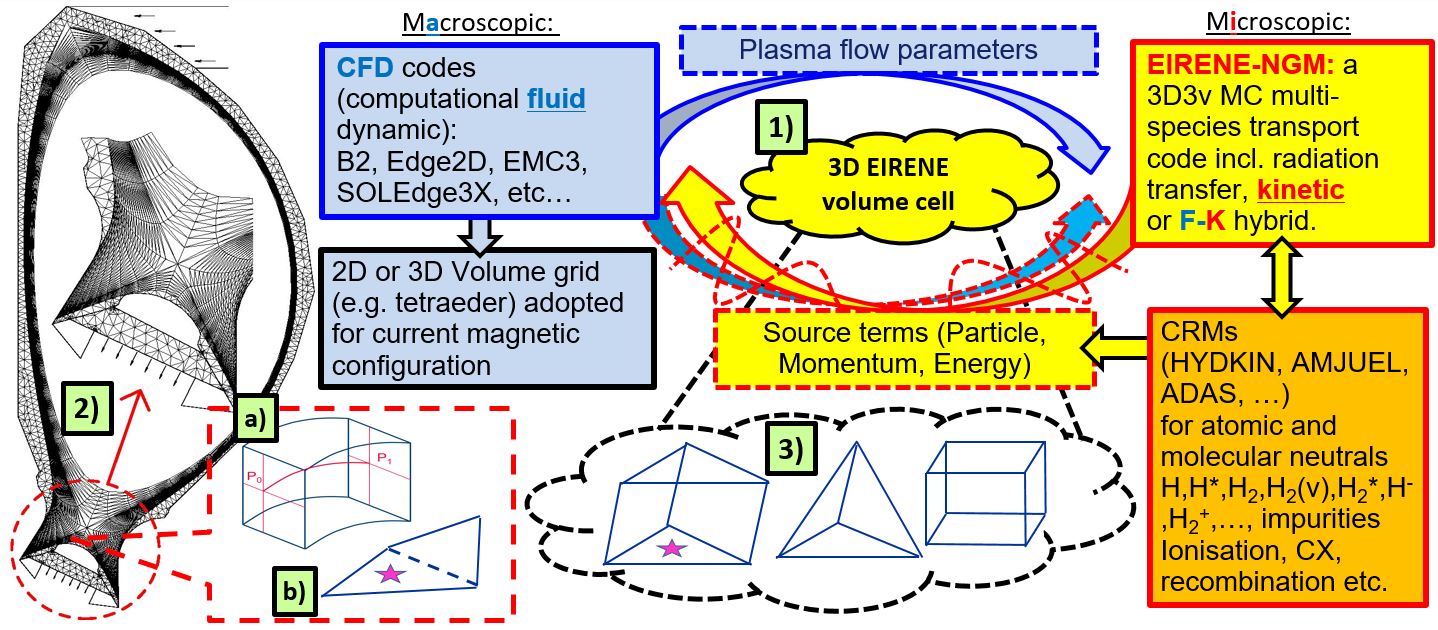|
|
EIRENE basics
|
EIRENE [Reiter05], also known as neutral gas module (NGM) is a multi-purpose Boltzmann-equation Monte Carlo (MC) solver typically employed in an iterative scheme with a fluid plasma code, succinctly referred to as computational fluid dynamics (CFD) code, see figure 1. A number of 2D CFD-EIRENE code packages such as SOLPS-ITER, EDGE2D-EIRENE, and SOLEdge2D-EIRENE are extensively employed by the fusion community (see Collaborations). Also the 3D codes are applied, such as EMC3-EIRENE or SolEdge3X-EIRENE, and are more demanding in terms of CPU and memory requirements. All the mentioned kinetic–fluid packages are under active development. They provide self-consistently generated plasma distributions of macroscopic properties (2D or 3D), heat and particle fluxes to the wall, synthetic spectroscopy and radiative losses. An essential part of the neutral MC tracing procedure are the collisional-radiative models (CRMs) for A&M processes involving main-plasma species and intrinsic/extrinsic impurities. This includes ionization–dissociation–recombination of A&M species, break-up chains of molecules in plasma, and elastic processes. The corresponding data, often in the form of Maxwellian-averaged rates, are provided both from some databases intentionally created for EIRENE (AMJUEL, HYDHEL, H2VIBR, .., see Documentation) and from external databases, such as ADAS. The former can be analysed and validated with the toolkit PLOUTOS.
Numerical simulations with a kinetic code such as EIRENE are indispensable for both understanding and predicting the fuel and impurity transport in the edge and divertor areas of fusion devices. The transport determines impurity penetration towards the core, plasma exhaust and plasma–surface interaction (PSI) issues having impact on the duty cycle of ITER and DEMO. The insight into the interplay of transport and atomic–molecular (A&M) processes provided by modelling is key for understanding of the detachment phenomenon, which is critical for many exhaust regimes envisaged for ITER and DEMO.

|
Figure 1. EIRENE-NGM iterative scheme with the CFD codes; the term NGM underlines the role of the code in the coupled packages like SOLPS. (1) The NGM runs simulations for a number of volume cells; (2) the CFD side determines magnetic configuration and runs itself on a grid optimized for it, where the cell shape typically mimics the magnetic field line geometry; this grid may be 3D like in EMC3 (a) or 2D, for instance quadrangular plasma cells (b) split into triangles (marked by the star) in SOLPS-ITER; (3) The EIRENE cells, always 3D, correspond to (or approximate) the CFD cells; for 2D CFD cells an extra dimension is provided (magenta stars mark corresponding triangles in 2D SOLPS and 3D EIRENE cells). EIRENE can run fully kinetic or, alternatively, a fraction of neutrals can be treated as fluid providing higher simulation performance; the corresponding fluid calculations are typically provided by the CFD side.
[Reiter05] Reiter D., Baelmans M. and Börner P. 2005 The EIRENE and B2-EIRENE codes Fusion Sci. Technol. 47 172–86
|
|
|


